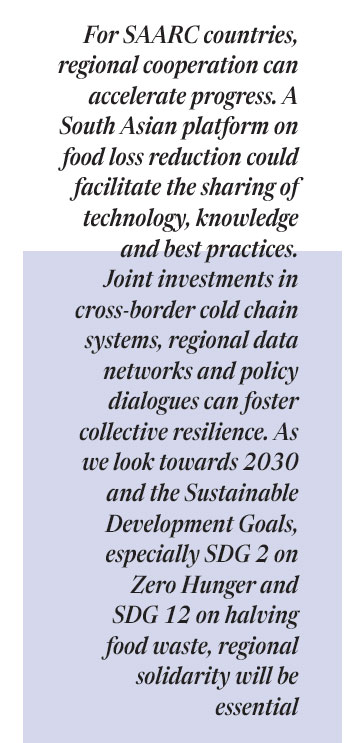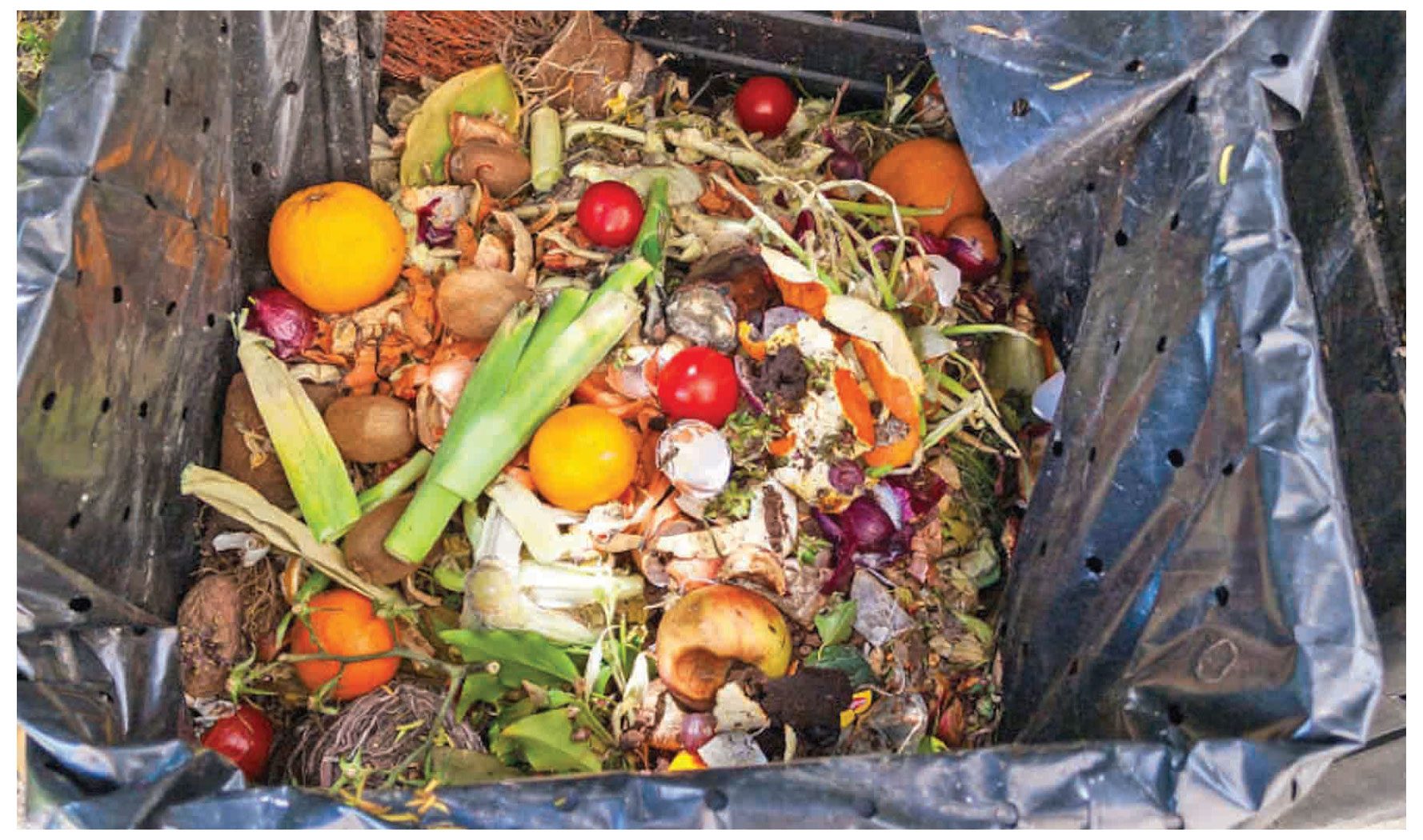
DR. MD. HARUNUR RASHID
Bangladesh has made a remarkable success story in agricultural development. Once struggling to feed its population, the country has transformed into a model of self-sufficiency and resilience. Rice production has increased from 13.6 million tonnes in 1980 to 40.6 million tonnes in 2024, while the outputs of potatoes, maize, fish, dairy and meat have grown impressively. These achievements reflect the nation’s progress in innovation, technology adoption and the tireless dedication of millions of farmers who feed the country. However, behind these encouraging figures lies a hidden challenge that threatens to undermine our progress in food loss and waste. Fruits, vegetables, grains and other staples often never reach the consumer’s table due to poor storage, inadequate or improper transportation and inefficient supply chains. Every grain wasted represents not only the loss of food but also of water, fertiliser, energy and human labour. As Bangladesh continues to increase agricultural production with degradation of resources, it must now focus with equal importance on reducing post-harvest losses to secure food and nutrition for all now and a sustainable food system for future generations.
Post-harvest losses remain a critical issue not just for Bangladesh but across South Asia. In the SAARC region, an estimated 20 to 44% of fruits and vegetables are lost after harvest due to poor infrastructure, handling and lack of cold storage facilities. Globally, about 13.2% of food is lost between harvest and retail, with perishable items such as fruits and vegetables experiencing losses as high as 40% in developing countries. In Bangladesh, nearly 11 million tonnes of food are lost or wasted every year, from farm to household. Fruits and vegetables suffer the most, with over 40% spoiling before consumption. Potatoes face an annual storage shortfall of around eight million tonnes, while rice, our staple crop, loses about 10% after harvest. Such wastage carries heavy economic and environmental costs. Lost rice alone drains the national economy of over 2.4 billion US dollars annually. Meanwhile, the energy, water, fertiliser and labour invested in producing the wasted food are also lost. Environmentally, these losses translate into nearly 10 million tonnes of carbon dioxide and three million tonnes of methane emissions each year, contributing to climate change and air pollution.
The human cost of food loss is equally alarming. Bangladesh continues to face the double burden of malnutrition, where undernutrition and overnutrition coexist. Millions of children still suffer from stunting and micronutrient deficiencies in zinc, iodine and vitamin D, while urban populations increasingly experience obesity, diabetes and diet-related diseases. As of 2024, about 13.9 million adults in Bangladesh are living with diabetes, representing 13.2% of the adult population. This stark contrast between hunger and overconsumption reveals deep inequalities in our food systems. It is a painful reminder that food security is not just about producing enough calories; it is about ensuring access to safe, nutritious and affordable food for all.
Food loss and waste occur throughout the supply chain, from production to consumption. On farms, the absence of modern equipment, poor harvesting practices and lack of training reduce both yield and quality. During transportation, the absence of cold chain logistics forces farmers to sell perishables quickly at low prices or watch them rot in transit. In markets, inadequate grading, unhygienic environments and weak packaging further erode quality. Even at home, cultural attitudes toward abundance and poor meal planning lead to significant household waste. For example, Bangladesh produces over 826,000 metric tonnes of bananas each year, yet around 21.7% are lost due to improper handling and inadequate post-harvest management.
The issue of food waste is not confined to Bangladesh. Globally, more than one billion tonnes of food are wasted annually, amounting to about 132 kilograms per person or nearly one in every five meals that could have been consumed. Households are responsible for about 60% of global food waste, followed by restaurants and retail sectors. If food waste were a country, it would rank as the third-largest emitter of greenhouse gases, after China and the United States. Many nations have started to act to reduce this wastage. India has proposed the Compulsory Food Waste Reduction Bill, while Malaysia has introduced the Food Loss and Waste Act. These initiatives seek to reduce national food waste through legislation, incentives and awareness campaigns. Bangladesh and other SAARC nations can benefit greatly from similar national frameworks to promote responsible practices and ensure that surplus food is distributed to those in need.
In this context, the 2025 World Food Day theme, “Hand in Hand for Better Foods and a Better Future”, carries special meaning for Bangladesh and South Asia. It calls for collaboration at every level among farmers, researchers, policymakers, traders and consumers. Working hand in hand can ensure that our food systems are efficient, inclusive and sustainable. It is also a reminder that our journey toward food security must not end at the farm gate. Food systems must integrate nutrition, sustainability and equity as core values.

Technological innovation offers promising solutions. Improved post-harvest technologies, such as hermetic storage bags, solar-powered cold rooms, evaporative coolers and smart packaging, can drastically reduce spoilage. Digital traceability systems can monitor temperature, humidity and logistics across the value chain, while small-scale food processing units near production zones can add value and reduce transportation losses. These innovations, however, must be made accessible to smallholders through hands-on training, financing and market linkages. Only then can technology become a true equaliser in the fight against food loss.
Nutrition security must also move to the centre of food policy. South Asia needs to shift from a calorie-focused approach to one that values dietary diversity and nutrient quality. Encouraging the production and consumption of fruits, vegetables, pulses, milk and fish alongside staples can improve health outcomes and dietary balance. The value chain approach linking farmers to processors, retailers and consumers can ensure fair pricing, better quality and reduced waste. Integrating biofortified crops, food fortification and nutrition education will help address the hidden hunger caused by micronutrient deficiencies.
Achieving the vision of better foods and a better future demands the involvement of all stakeholders. Governments must lead with clear policy frameworks and investment in infrastructure development, research & development and knowledge management. Research institutions must develop affordable, climate-smart technologies suited to local conditions. The private sector must drive innovation, sustainability and responsible production. Civil society and development partners must promote awareness and capacity building, while consumers must take responsibility to reduce household waste and make informed choices.
For SAARC countries, regional cooperation can accelerate progress. A South Asian platform on food loss reduction could facilitate the sharing of technology, knowledge and best practices. Joint investments in cross-border cold chain systems, regional data networks and policy dialogues can foster collective resilience. As we look towards 2030 and the Sustainable Development Goals, especially SDG 2 on Zero Hunger and SDG 12 on halving food waste, regional solidarity will be essential.
Food is more than nutrition; it is dignity, equity and hope. Wasting it is both an economic and moral failure. Every grain of rice, every drop of milk, and every piece of fruit carries the hard work of our farmers and the resources of our planet. Through collective effort, innovation and compassion, we can ensure that the food we grow truly nourishes people and sustains the planet. In doing so, we will not only protect our agricultural legacy but also secure a healthier, fairer and more sustainable future hand in hand for generations to come.
________________________________
The writer is a Director, SAARC Agriculture Centre, Bangladesh

